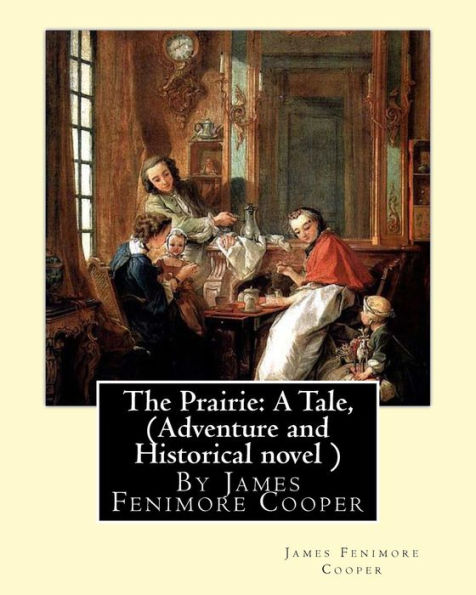5
1

The Prairie: A Tale, By James Fenimore Cooper (Adventure and Historical novel )
250
by James Fenimore Cooper
James Fenimore Cooper

The Prairie: A Tale, By James Fenimore Cooper (Adventure and Historical novel )
250
by James Fenimore Cooper
James Fenimore Cooper
Paperback
$11.99
-
PICK UP IN STORECheck Availability at Nearby Stores
Available within 2 business hours
Related collections and offers
11.99
In Stock
Overview
The Prairie: A Tale (1827) is a novel by James Fenimore Cooper, the third novel . Plot--The story opens with Ishmael, his family, Ellen and Abiram slowly making their way across the virgin prairies of the Midwest looking for a homestead, just two years after the Louisiana Purchase, and during the time of the Lewis and Clark Expedition. They meet the trapper (Natty Bumppo), who has left his home in New York state to find a place where he cannot hear the sound of people cutting down the forests. In the years between his other adventures and this novel, he tells us only that he has walked all the way to the Pacific Ocean and seen all the land between the coasts[citation needed] (a heroic feat, considering Lewis and Clark hadn't yet completed the same trek). That night, a band of Teton warriors steal all of Ishmael's animals, stranding the immigrants. The doctor returns the next morning along with his donkey. The trapper helps the family relocate their wagons, including one with mysterious contents, to a nearby butte where they will be safer when the Tetons return. Middleton joins the group when he stumbles upon the trapper and Paul. Before they return to the butte, Ishmael and his family go looking for his eldest son, Asa, whom they find murdered. The trapper, Paul, and Middleton return to camp, find Inez whom Abiram and Ishmael had been keeping captive, and flee with her and Ellen. Ishmael chases them until the Tetons capture the Trapper and his crew. They escape the Tetons, and then Ishmael forms an alliance with the Indians. The Indians attempt to recapture the trapper by surrounding them with a prairie fire, but the trapper lights a backfire and saves everyone. They meet up with Hard-heart, a Pawnee Indian who survived the fire wrapped in a buffalo skin, and attempt to escape to his village. The Tetons capture them. Ishmael demands the trapper, Inez, and Ellen for helping the Tetons but is denied and turned away. Mahtoree intends to take Inez and Ellen for his new wives. Le Balafre attempts to spare Hard-heart's life by making Hard-heart his son. Hard-heart refuses, kills Weucha, and flees the village. When Hard-heart's Pawnee warriors attack the Teton village, the trapper and his friends escape, only to be captured by Ishmael. The trapper is accused of Asa's death until Abiram's guilt is discovered. Abiram is executed, and Ishmael's family returns east without Inez, Ellen, or the doctor. Middleton, Inez, Paul and Ellen travel back to Louisiana and Kentucky, respectively, while the trapper joins a Pawnee village located on a tributary of the Missouri River. Middleton and Paul return just in time to witness the trapper's noble death and bury him.Treatment of Indians As with The Last of the Mohicans, one of Cooper's major themes in The Prairie is the idea of a noble savage. The book contrasts Hard-heart and the Pawnee tribe-who were at peace with the white settlers-to the warlike Tetons. The Tetons are categorically described as cunning, crafty, deceitful, loathsome and dirty. Hard-heart is brave, fierce, and fights to protect his honor. He refuses to abandon his tribe, even if he loses his life for it. In contrast, Le Balafre once abandoned his tribe to become a Teton, thus saving his own life. In the end, Hard-heart is alive while Weucha and Mahtoree are dead. The doctor, horrified at the possibility of being forced to marry an Indian wife, refers to them as a different species, not homo sapiens. The Tetons are frequently referred to as looking like snakes or with other snake symbolism, such as having "forked tongues". Although Cooper's Indians are frequently stereotypical, so are his white characters. Despite sometimes referring prejudicially to Indians as subhuman, he still presents them in a complex light, a mixture of human and devilish characteristics. Amidst what Cooper describes as primitive or dirty, he lauds their honor, hospitality, laws, etc. ...

Product Details
| ISBN-13: | 9781535101103 |
|---|---|
| Publisher: | CreateSpace Publishing |
| Publication date: | 07/05/2016 |
| Pages: | 250 |
| Sales rank: | 486,443 |
| Product dimensions: | 7.99(w) x 10.00(h) x 0.53(d) |
About the Author
The creator of two genres that became staples of American literature — the sea romance and the frontier adventure — James Fenimore Cooper (1789-1851) was born in New Jersey, raised in the wilderness of New York, and spent five years at sea before embarking on his successful writing career. Among Cooper’s many novels, his best-known books are the five "Leatherstocking" tales — including The Deerslayer and The Last of the Mohicans — each featuring the fictional hero Natty Bumppo.
Date of Birth:
September 15, 1789Date of Death:
September 14, 1851Place of Birth:
Burlington, New JerseyPlace of Death:
Cooperstown, New YorkEducation:
Yale University (expelled in 1805)From the B&N Reads Blog
Page 1 of
